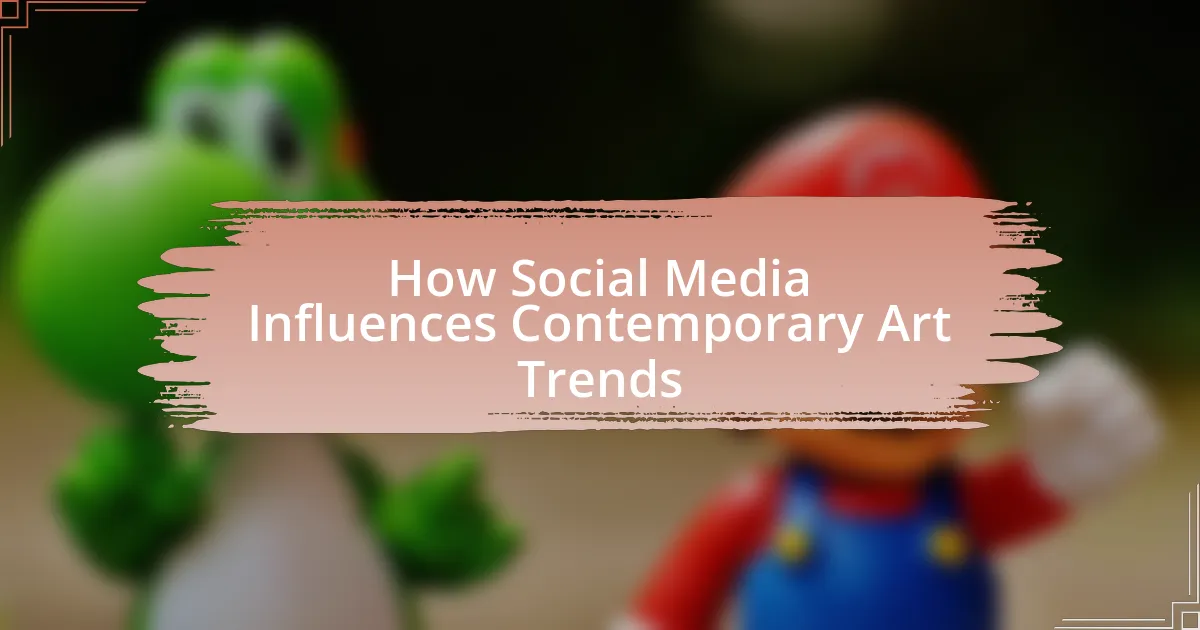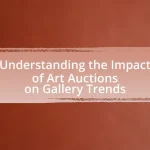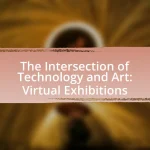The article examines the significant influence of social media on contemporary art trends, highlighting how platforms like Instagram and TikTok provide artists with opportunities to showcase their work, engage with global audiences, and receive real-time feedback. It discusses the democratization of artistic expression, the visibility of emerging artists, and the impact of social media on audience engagement and traditional art institutions. Additionally, the article addresses the challenges artists face in navigating social media, the emergence of new art forms, and strategies for effectively leveraging these platforms to enhance their careers and foster collaboration within the art community.
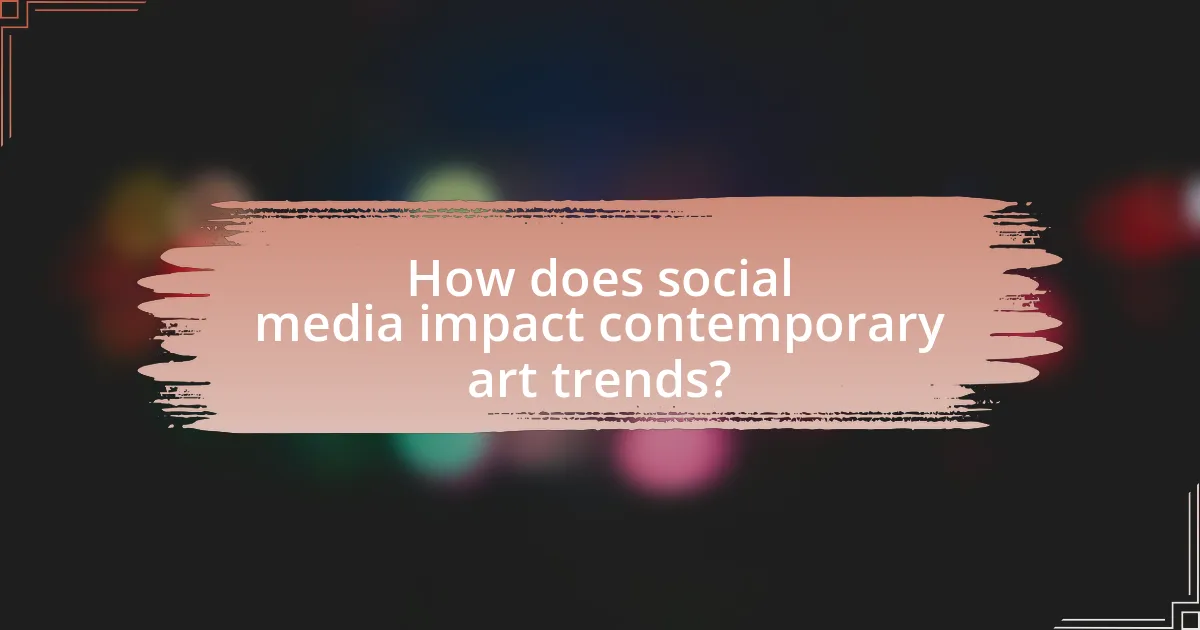
How does social media impact contemporary art trends?
Social media significantly impacts contemporary art trends by providing artists with a platform to showcase their work and engage with a global audience. This accessibility allows for diverse artistic expressions to gain visibility, leading to the rapid dissemination of new styles and ideas. For instance, platforms like Instagram have become essential for artists to build their brands, with over 1 billion monthly active users facilitating the sharing of visual content. Additionally, social media enables real-time feedback and interaction, influencing artists’ creative processes and trends. Research indicates that 70% of artists use social media to promote their work, highlighting its role in shaping contemporary art landscapes.
What role does social media play in shaping artistic expression?
Social media significantly influences artistic expression by providing artists with platforms to showcase their work, connect with audiences, and receive immediate feedback. This democratization of art allows for diverse voices and styles to emerge, as artists can share their creations without traditional gatekeeping. For instance, platforms like Instagram and TikTok have enabled artists to gain visibility and build followings, leading to new trends and movements in contemporary art. According to a 2021 report by Art Basel and UBS, 63% of collectors discovered new artists through social media, highlighting its role in shaping artistic landscapes and trends.
How do artists utilize social media platforms for their work?
Artists utilize social media platforms to showcase their work, engage with audiences, and build their personal brands. By posting images, videos, and live streams of their art, artists can reach a global audience, allowing for immediate feedback and interaction. For instance, platforms like Instagram and TikTok have become essential for artists to share their creative processes and finished pieces, leading to increased visibility and potential sales. According to a survey by Artfinder, 70% of artists reported that social media significantly impacted their ability to sell art, highlighting its role in contemporary art trends.
What are the effects of social media on audience engagement with art?
Social media significantly enhances audience engagement with art by providing platforms for interaction, sharing, and community building. Artists and institutions utilize social media to showcase their work, leading to increased visibility and accessibility for diverse audiences. For instance, a study by the Pew Research Center found that 69% of adults in the U.S. use social media, which facilitates real-time feedback and dialogue between artists and viewers. This interaction fosters a sense of community and belonging, as audiences can connect with artists and each other through comments, shares, and likes, ultimately driving greater interest and participation in the art world.
Why is social media a vital tool for contemporary artists?
Social media is a vital tool for contemporary artists because it provides a platform for direct engagement with audiences and potential buyers. This engagement allows artists to showcase their work, receive immediate feedback, and build a personal brand without the need for traditional galleries. According to a 2021 survey by Art Basel and UBS, 70% of artists reported that social media significantly increased their visibility and sales opportunities. Furthermore, platforms like Instagram and TikTok have become essential for art discovery, with millions of users exploring and sharing artwork daily, thus amplifying an artist’s reach and influence in the art community.
How does social media influence the visibility of emerging artists?
Social media significantly enhances the visibility of emerging artists by providing them with direct access to a global audience. Platforms like Instagram, TikTok, and Twitter allow artists to showcase their work, engage with followers, and build a personal brand without the need for traditional galleries or intermediaries. According to a 2021 survey by Artfinder, 70% of artists reported that social media was their primary tool for gaining exposure and connecting with potential buyers. This democratization of visibility enables artists to reach diverse demographics, fostering community engagement and collaboration.
What are the implications of social media for traditional art institutions?
Social media significantly impacts traditional art institutions by altering how art is marketed, consumed, and engaged with. Traditional art institutions, such as galleries and museums, now face the challenge of adapting to a digital landscape where social media platforms serve as primary venues for art promotion and audience interaction. For instance, institutions like the Tate Modern have successfully utilized platforms like Instagram to reach wider audiences, showcasing exhibitions and engaging users through interactive content. This shift has led to increased visibility for artists and democratized access to art, allowing individuals to experience art beyond physical spaces. Furthermore, social media analytics provide institutions with valuable insights into audience preferences, enabling them to tailor programming and outreach efforts effectively.
What challenges do artists face when using social media?
Artists face several challenges when using social media, including algorithm changes, oversaturation of content, and the pressure to maintain engagement. Algorithm changes can limit the visibility of an artist’s work, making it difficult for them to reach their audience effectively. Oversaturation occurs as countless artists share their work, leading to competition for attention and making it harder for individual pieces to stand out. Additionally, the pressure to consistently produce content and engage with followers can detract from the creative process, potentially impacting the quality of the art itself. These challenges highlight the complexities artists navigate in leveraging social media for their careers.
How does the fast-paced nature of social media affect artistic quality?
The fast-paced nature of social media often diminishes artistic quality by prioritizing speed and virality over depth and craftsmanship. Artists may feel pressured to produce content rapidly to maintain visibility and engagement, leading to a focus on trends rather than originality. Research indicates that this environment can result in superficial engagement with art, as audiences often favor easily consumable pieces over those that require contemplation. For instance, a study published in the journal “Art & Perception” highlights that rapid consumption of art on platforms like Instagram can lead to a decline in critical appreciation, as users scroll through images without fully engaging with their context or meaning.
What are the risks of relying on social media for artistic validation?
Relying on social media for artistic validation poses several risks, including the potential for superficial engagement, the influence of algorithms on visibility, and the pressure to conform to trends. Superficial engagement can lead artists to prioritize likes and shares over genuine artistic expression, which may dilute their creativity. Algorithms often favor content that aligns with popular trends, potentially marginalizing unique or innovative works that do not fit established norms. Additionally, the pressure to conform to trending aesthetics can stifle originality, as artists may feel compelled to create work that appeals to the masses rather than pursuing their authentic vision. These factors can ultimately undermine the integrity of the artistic process and the value of art itself.

What are the specific trends in contemporary art driven by social media?
Contemporary art trends driven by social media include increased accessibility, the rise of digital art forms, and the prominence of participatory and interactive art experiences. Social media platforms enable artists to reach wider audiences, allowing for the democratization of art, where anyone can share their work and gain visibility. The popularity of digital art, including NFTs, has surged, with platforms like Instagram and TikTok serving as primary venues for showcasing and selling these works. Additionally, social media fosters participatory art, where audiences engage directly with the artwork, often through user-generated content or collaborative projects, exemplified by initiatives like the #ArtChallenge movement. These trends illustrate how social media reshapes the landscape of contemporary art, influencing both creation and consumption.
How has social media changed the way art is created and shared?
Social media has fundamentally transformed the creation and sharing of art by providing artists with immediate access to a global audience and facilitating real-time feedback. Platforms like Instagram and TikTok allow artists to showcase their work instantly, bypassing traditional gatekeepers such as galleries and curators. This democratization of art has led to diverse artistic expressions and increased visibility for underrepresented artists. According to a 2021 survey by Art Basel and UBS, 70% of collectors reported discovering new artists through social media, highlighting its role in shaping contemporary art trends and market dynamics.
What new art forms have emerged due to social media platforms?
New art forms that have emerged due to social media platforms include digital art, meme art, and interactive installations. Digital art has gained prominence as artists utilize software and online tools to create and share their work instantly with a global audience. Meme art, characterized by the use of humor and cultural references, has become a popular medium for commentary on social issues, often going viral across platforms like Instagram and Twitter. Interactive installations leverage social media for audience engagement, allowing viewers to participate in the artwork through their devices, thus blurring the lines between creator and audience. These developments reflect the transformative impact of social media on artistic expression and accessibility.
How do viral trends influence artistic styles and themes?
Viral trends significantly influence artistic styles and themes by shaping the content that artists create and the mediums they use. For instance, the rise of platforms like Instagram and TikTok has led to the popularity of visual aesthetics that prioritize immediacy and shareability, such as bold colors and simplified forms. This shift is evidenced by the emergence of specific art movements, like digital art and meme culture, which reflect the rapid consumption of visual content online. Additionally, artists often respond to viral challenges or themes, integrating them into their work to engage with contemporary audiences, as seen in the widespread adoption of social commentary in art that resonates with trending societal issues.
What are the most popular social media platforms for artists today?
The most popular social media platforms for artists today are Instagram, TikTok, and Pinterest. Instagram is widely recognized for its visual-centric approach, boasting over 1 billion monthly active users, making it a prime space for artists to showcase their portfolios and engage with audiences. TikTok, with its rapid growth and emphasis on short-form video content, has become a vital platform for artists to share their creative processes and reach younger demographics, with over 1 billion monthly active users as of 2023. Pinterest serves as a visual discovery engine, allowing artists to curate inspiration and connect with potential clients, with over 450 million monthly active users. These platforms collectively provide artists with significant visibility and engagement opportunities in the contemporary art landscape.
How does Instagram shape visual art trends?
Instagram shapes visual art trends by providing a platform for artists to showcase their work to a global audience, facilitating immediate feedback and engagement. The visual-centric nature of Instagram encourages artists to create eye-catching content that resonates with viewers, often leading to the emergence of specific styles and aesthetics that gain popularity. For instance, the rise of vibrant color palettes and minimalistic designs can be traced back to the visual preferences expressed by users on the platform. Additionally, Instagram’s algorithm promotes trending content, allowing certain artworks to gain visibility and influence the direction of contemporary art. This dynamic interaction between artists and audiences on Instagram has resulted in a rapid evolution of visual art trends, as seen in the increased popularity of digital art and mixed media, which are frequently shared and celebrated within the community.
What role does TikTok play in promoting contemporary art?
TikTok plays a significant role in promoting contemporary art by providing a platform for artists to showcase their work to a global audience. The app’s algorithm favors engaging content, allowing artists to gain visibility and connect with potential buyers and fans quickly. For instance, the hashtag #ArtTok has garnered millions of views, highlighting the popularity of art-related content on the platform. Additionally, TikTok facilitates collaboration among artists and encourages trends that can lead to viral art movements, further enhancing the reach and impact of contemporary art.
How do social media challenges impact artistic collaboration?
Social media challenges significantly enhance artistic collaboration by providing a platform for artists to connect, share ideas, and co-create. These challenges often encourage participation from diverse artists across various disciplines, fostering a sense of community and collective creativity. For instance, the viral nature of challenges like the Ice Bucket Challenge or the Mannequin Challenge has led to collaborative projects that blend different artistic forms, such as visual art, music, and performance. Research indicates that platforms like Instagram and TikTok facilitate these interactions, with over 70% of artists reporting increased collaboration opportunities due to social media engagement. This interconnectedness not only broadens the reach of individual artists but also enriches the artistic landscape by merging different styles and perspectives.
What are the benefits of collaborative projects initiated through social media?
Collaborative projects initiated through social media enhance creativity, expand reach, and foster community engagement. These projects allow artists and creators to pool their resources and ideas, leading to innovative outcomes that may not be achievable individually. For instance, a study by the Pew Research Center found that 72% of adults use social media, providing a vast audience for collaborative art initiatives. Additionally, social media platforms facilitate real-time feedback and interaction, which can refine artistic processes and strengthen community ties. This interconnectedness not only promotes diverse perspectives but also encourages participation from a global audience, enriching the collaborative experience.
How do online art communities foster innovation and experimentation?
Online art communities foster innovation and experimentation by providing platforms for artists to share ideas, collaborate, and receive immediate feedback. These communities encourage diverse artistic expressions and techniques, allowing members to explore unconventional methods and styles. For instance, platforms like Instagram and DeviantArt enable artists to showcase their work to a global audience, facilitating cross-cultural exchanges that inspire new concepts. Additionally, the accessibility of digital tools and resources within these communities promotes experimentation, as artists can easily access tutorials, challenges, and peer support. Research indicates that artists engaged in collaborative projects within online communities report higher levels of creativity and innovation, demonstrating the significant impact of these networks on contemporary art practices.
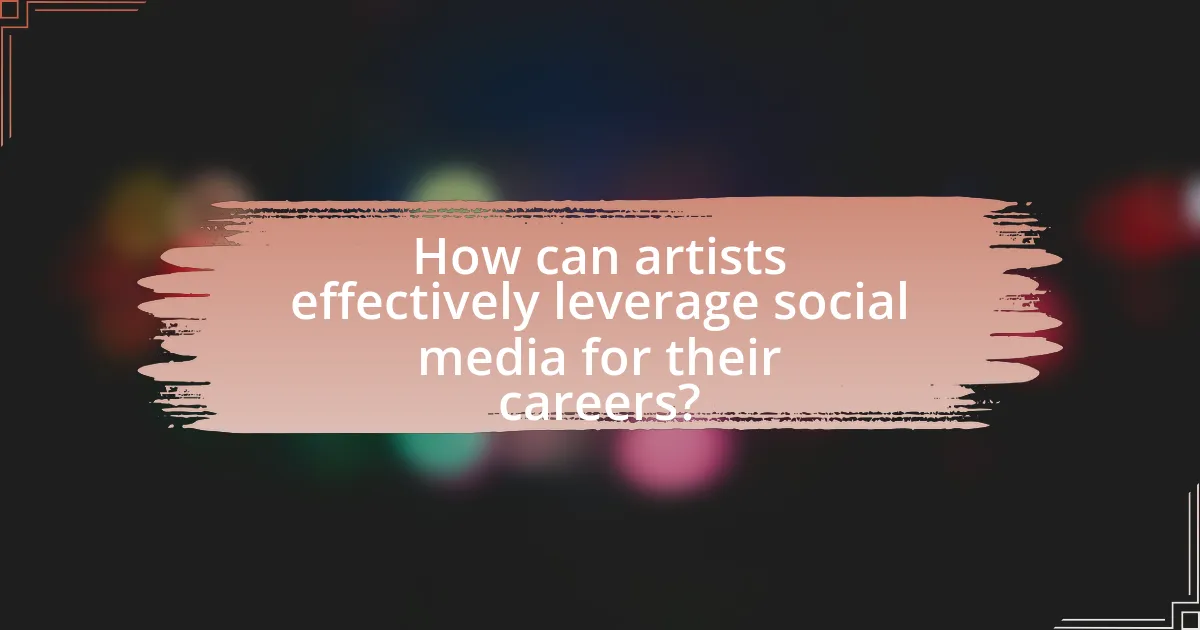
How can artists effectively leverage social media for their careers?
Artists can effectively leverage social media for their careers by creating engaging content, building a personal brand, and connecting with their audience. Engaging content, such as behind-the-scenes videos, live art sessions, and interactive posts, can attract followers and increase visibility. Building a personal brand involves consistent messaging and aesthetics across platforms, which helps establish recognition and trust. Connecting with the audience through comments, direct messages, and collaborations fosters community and loyalty. According to a 2021 survey by the National Endowment for the Arts, 72% of artists reported that social media significantly impacted their ability to reach new audiences and sell their work, demonstrating the effectiveness of these strategies.
What strategies should artists adopt for successful social media engagement?
Artists should adopt a multi-faceted approach to social media engagement that includes consistent content creation, audience interaction, and strategic use of analytics. Consistent content creation helps maintain visibility and keeps followers engaged; for instance, posting regularly can increase follower retention by up to 50%. Audience interaction, such as responding to comments and messages, fosters community and loyalty, which is crucial in building a supportive fan base. Additionally, utilizing analytics tools allows artists to track engagement metrics, enabling them to refine their strategies based on what resonates most with their audience. This data-driven approach ensures that artists can adapt their content to meet the preferences of their followers, ultimately enhancing their social media presence and influence in contemporary art trends.
How can artists build a personal brand on social media?
Artists can build a personal brand on social media by consistently sharing their unique artistic vision and engaging with their audience. This involves creating high-quality content that showcases their work, such as images, videos, and behind-the-scenes processes, which helps to establish their identity. Engaging with followers through comments, live sessions, and collaborations fosters a sense of community and loyalty.
According to a survey by Hootsuite, 73% of marketers believe that their efforts through social media marketing have been “somewhat effective” or “very effective” for their business, indicating the potential impact of social media on brand building. Additionally, using relevant hashtags and participating in trending conversations can increase visibility and attract a broader audience, further solidifying an artist’s brand presence online.
What types of content resonate most with art audiences online?
Visual content, particularly high-quality images and videos of artwork, resonates most with art audiences online. This preference is supported by data indicating that posts featuring images receive 94% more views than text-only posts on social media platforms. Additionally, behind-the-scenes content, artist interviews, and interactive elements like polls or Q&A sessions engage audiences effectively, fostering a deeper connection with the art and the artists. Research from the National Endowment for the Arts shows that visual arts participation has increased significantly due to online platforms, highlighting the importance of visually appealing content in attracting and retaining art audiences.
What best practices should artists follow when using social media?
Artists should maintain a consistent posting schedule on social media to engage their audience effectively. Regular updates keep followers informed about new work, exhibitions, and events, fostering a sense of community. Research indicates that brands and individuals who post consistently see a 50% increase in engagement rates. Additionally, artists should utilize high-quality visuals to showcase their work, as posts with images receive 94% more views than text-only posts. Engaging with followers through comments and direct messages builds relationships and encourages loyalty, which is crucial in the art community. Lastly, artists should leverage analytics tools to track engagement and adjust their strategies accordingly, as data-driven decisions can enhance visibility and reach.
How can artists maintain authenticity while promoting their work online?
Artists can maintain authenticity while promoting their work online by staying true to their unique voice and vision. This involves sharing genuine insights into their creative process, engaging with their audience in an honest manner, and avoiding trends that do not align with their artistic identity. Research indicates that artists who consistently express their personal narratives and values tend to build stronger connections with their audience, leading to increased trust and loyalty. For instance, a study published in the Journal of Arts Management, Law, and Society found that authenticity in online engagement significantly enhances audience perception and support for artists.
What are the common pitfalls to avoid in social media marketing for artists?
Common pitfalls to avoid in social media marketing for artists include inconsistent branding, neglecting audience engagement, and failing to analyze performance metrics. Inconsistent branding can confuse potential followers and dilute an artist’s identity, making it crucial to maintain a cohesive visual and thematic presence across platforms. Neglecting audience engagement leads to missed opportunities for building a loyal fan base; artists should actively respond to comments and messages to foster community. Lastly, failing to analyze performance metrics can result in ineffective strategies; artists should regularly review analytics to understand what content resonates with their audience and adjust their approach accordingly.
What resources are available for artists to enhance their social media presence?
Artists can enhance their social media presence through various resources, including social media management tools, online courses, and community platforms. Tools like Hootsuite and Buffer allow artists to schedule posts and analyze engagement metrics, which can improve their outreach and effectiveness. Online courses from platforms such as Skillshare and Coursera offer training on social media marketing strategies tailored for artists, helping them understand best practices and audience engagement. Additionally, community platforms like Facebook Groups and Reddit provide spaces for artists to connect, share experiences, and gain insights from peers, fostering collaboration and support in navigating social media landscapes.
How can artists utilize analytics to improve their social media strategies?
Artists can utilize analytics to improve their social media strategies by analyzing engagement metrics to understand audience preferences and optimize content accordingly. By examining data such as likes, shares, comments, and follower demographics, artists can identify which types of posts resonate most with their audience. For instance, a study by Hootsuite found that posts with images receive 650% more engagement than text-only posts, highlighting the importance of visual content. Additionally, tracking the performance of different posting times can help artists schedule their content for maximum visibility, as research indicates that posts made during peak user activity times yield higher engagement rates. By leveraging these insights, artists can tailor their social media presence to better connect with their audience and enhance their overall impact.
What tools can assist artists in managing their social media accounts effectively?
Artists can effectively manage their social media accounts using tools like Hootsuite, Buffer, and Later. Hootsuite allows users to schedule posts across multiple platforms, track engagement metrics, and manage interactions in one dashboard, which is crucial for maintaining a consistent online presence. Buffer offers similar scheduling capabilities and provides analytics to help artists understand their audience better, enabling them to tailor their content accordingly. Later specializes in visual content planning, making it ideal for artists who rely heavily on imagery, as it allows for a visually appealing layout of posts before they go live. These tools enhance efficiency and engagement, which are essential for artists looking to leverage social media for their visibility and brand development.
